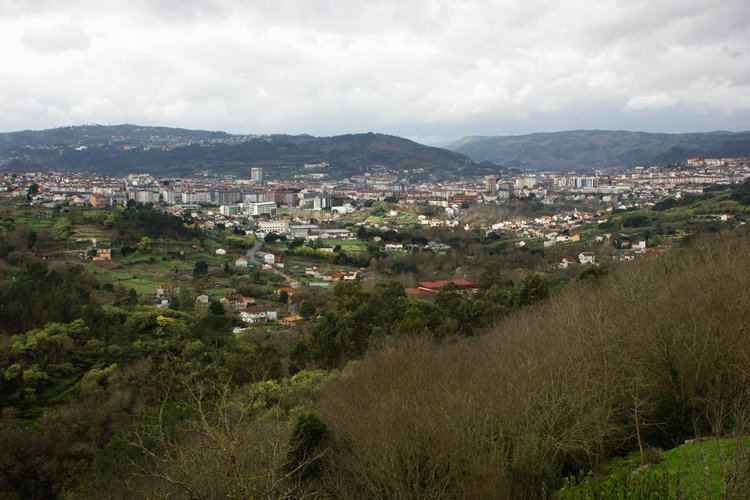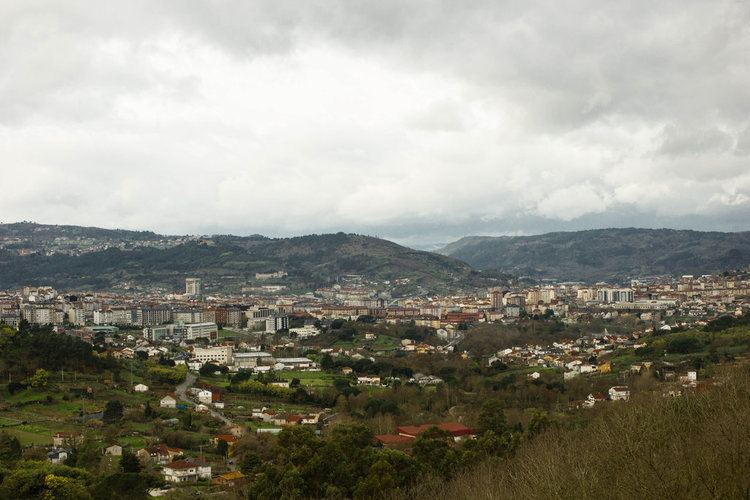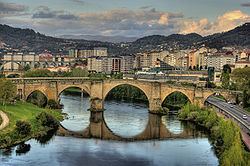Country | Population 107,597 (2012) Area 85.2 km2 | |
 | ||
Mayor Agustin Fernandez Gallego (Socialist Party of Galicia) | ||
Map of Ourense
Ourense ([owˈɾɛnse]; Spanish: Orense [oˈɾense]) is a city in northwestern Spain, the capital of the province of the same name in Galicia.
Contents
- Map of Ourense
- Verin ourense galicia spain
- What to see eat in ourense galicia spain
- Population
- History
- Geography and geothermal springs
- Climate
- Economy
- Sights
- Transport
- Barallete
- Notable residents
- References

Verin & ourense galicia, spain
What to see & eat in ourense galicia, spain
Population

Its population of 106,905 (2014) accounts for 30% of the population of the province and makes it the third largest city of Galicia.
In 2010 there were 5,943 foreigners living in the city, representing 5.46% of the total population. The main nationalities are Portuguese (18%), Colombians (12%) and Brazilians (11%).
By language, according to 2008 data, 19% of the population always speak in Galician, 25% always speak in Spanish and the rest use both interchangeably.
History
The origin of the town can be traced to the Romans and the presence of hot springs called the Burgas. These can still be seen today. There was also the need to fortify the place to protect one of the easiest ways to cross the Miño River. After the Romans, Ourense was part of the Suebi (Suevi) kingdom during most of the 5th, 6th and 7th centuries and was destroyed by the Moors in 716. It was later rebuilt by Alfonso III of Asturias about 877. The Norse invasions as well as attacks from the Arab warlord Al-Mansur once more laid the city to waste. It was only under Sancho II and his sister Doña Elvira that the city was resettled during the 11th century. The definitive urban impulse did not arrive until the 12th century when Ourense became an important center of services. Recently the city has made many efforts to provide new parks, bridges, fountains and geothermal springs installations to make the city more attractive.
Geography and geothermal springs
The ancient city of Auria is located on both banks of the Minho (Miño) River in the south-central part of Galicia, at an elevation of 128 m above sea level.
Four rivers cross the town: Miño (the main river), Barbaña, Loña and Barbañica. The biggest river divides a rather industrial western suburb, which contains the railroad station, from the main town. Three highway and one railroad bridge cross the river in addition to the famous Roman bridge, Ponte Vella, which is now closed to vehicle traffic. The town is surrounded by forests, mainly oak and pine.
One of the main tourist attractions is related to hot springs, as Ourense holds one of the greatest amount of geothermal water in Europe. There are several places called pozas, with or without entrance fee, where you can have a bath outdoors. One of them is located inside the old town, relating to the ancient Roman tradition, as ruins of a Roman bath were discovered and are now open to visitors. There are more hot springs located along the river Miño: A Chavasqueira, Manantial-bouvette do Tinteiro, Burga do Muíño, Burgas de Outariz, which offer baths at different temperatures, ranging from 36 - 60 degrees Celsius.
Climate
Ourense has a Mediterranean climate (Köppen Csa). Summers have hot daytime temperatures around 30 °C (86 °F), whilst winters are wet with daytime highs at 12 °C (54 °F) and lows a few degrees above freezing.
Economy
The economy in the city of Ourense is marked by a predominance of service sector, the city has the largest shopping and leisure in the province, and administrative services (Xunta delegation, central and provincial government offices), educational (campus of the University of Vigo) and health (Ourense Hospital Complex) of reference. Construction industry is also important (Copasa, one of the biggest Galician construction companies, has its headquarters in the city).
The industrial area of San Cibrao das Viñas has many light industries including several important clothing factories, like Adolfo Dominguez and Roberto Verino, as well as automotive supplier industries.
Tecnopole, Technology Park of Galicia, situated in the outskirts of the city, is a 550.000 square metre area with advanced services for companies with a technological basis and high innovating profile. The following centres do their business work from the Tecnopole: the wood technological centres (CIS-Madeira), the meat technological centre (Centro Tecnolóxico da Carne), the metallurgy centre (Aimen) and the Coren Incubation Centre (CTI), the Research, Transfer and Innovation Centre (Centro de Innovación, Transferencia e Investigación or CITI) of the University of Vigo, and the Official Laboratory of Meteorology of Galicia ( Laboratorio Oficial de Metereoloxía de Galicia or LOMG).
Ourense is a well known producer of European chestnuts (Castanea sativa).
Coren, one of the Spanish agricultural sector's most important companies, has its headquarters in Ourense. The most read province newspaper is La Región.
Sights
Although mainly a town of services, Ourense is not without its tourist sites. The town has three parts: the medieval, the area of 19th-century expansion, and the modern perimeter. Many who pass by on the highway linking Madrid to Vigo are unaware of the medieval quarter, with its narrow streets and tiny plazas. Once an area of a certain dilapidated charm the area is now undergoing renovation and is full of typical restaurants and bars patronized by the university students of the town. The Plaza Mayor is the center of city life with its arcaded shops and the Town Hall.
The Cathedral is the most important monument in Ourense. This cathedral (founded 572; rebuilt in the 13th century) is the second oldest in Galicia. It occupies the same site as the Suevian basilica that stood there in earlier times. Romanesque in structure, but with a mixture of Romanesque and Gothic styles, it is rather hidden away but, contains a façade with the Door of Paradise in imitation of the Door of Glory of the Cathedral of Santiago de Compostela. Inside, the Capilla del Cristo, or Christ's Chapel (16th century), contains a crucifix venerated throughout Galicia.
The Miño is crossed at Ourense by the Ponte Vella (Old Bridge). With Roman foundations, it was reconstructed by Bishop Lorenzo in 1230 but frequently repaired since then; it has seven arches and a central span of 141 feet (43 m).
Transport
The city is served by the Ourense Railway Station.
Barallete
Barallete was the name of an argot employed by the traditional knife-sharpeners and umbrella holders (afiadores e paragüeiros) of Ourense. It was based on the Galician language as spoken in Ourense, but its users substituted everyday words with invented ones of no linguistic connection, making it impossible for other people to understand it.
Notable residents
Los Muchachos circus has a permanent polyhedron tent in Benposta, Seixalbo, Ourense.
